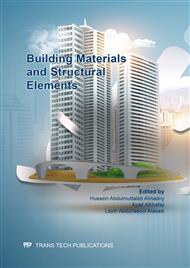p.31
p.41
p.50
p.59
p.68
p.77
p.88
p.97
p.110
Improvement of Quality of Concrete and Reducing Corrosion of Steel Reinforcement by Using Polypropylene Fibers, Styrene-Butadiene Rubber, and Integral Waterproofing Admixture
Abstract:
Reinforced concrete foundation, rigid pavements, and other structural members with attachment with ground or salty water like piers or retaining walls and others, subjected to chloride and sulfate salts attacks and that leads to damaging the structures or at least reduce durability, some concrete admixtures like waterproofing admixtures or polymers reduce permeability and increase mechanical properties and also durability. This research aims to improve the quality of concrete and reducing corrosion of steel reinforcement by using integral waterproofing admixture, styrene-butadiene rubber (SBR) and polypropylene fibers. mechanical properties such as compressive, flexural strength highly improved in this study. The reduction of weight of steel reinforcement by subjecting reinforced concrete specimens to chloride water (6% concentration) was 2.61 % for ordinary reinforced concrete and by using waterproof –polymer concrete with poly fibers, the reduction was less and its value was 0.93% and that was for 6 months’ exposure, and for 1-year exposure, the reduction in steel reinforcement weight was 4.72% for ordinary concrete and 1.4% for waterproof concrete.
Info:
Periodical:
Pages:
68-76
Citation:
Online since:
August 2021
Keywords:
Price:
Сopyright:
© 2021 Trans Tech Publications Ltd. All Rights Reserved
Share:
Citation:


